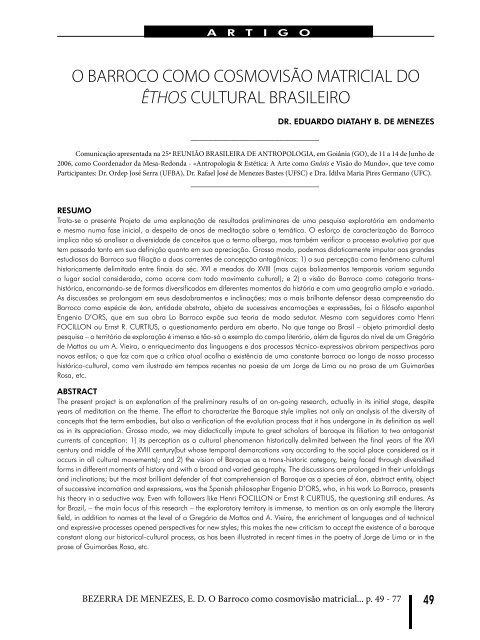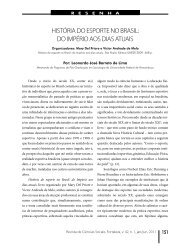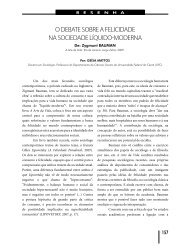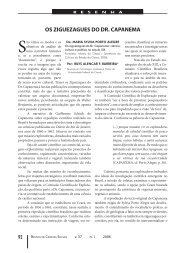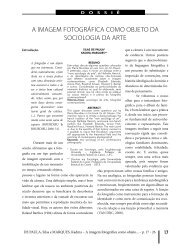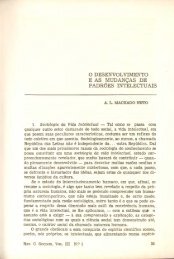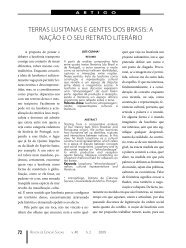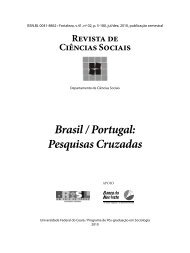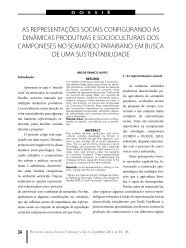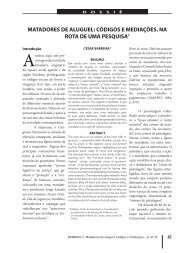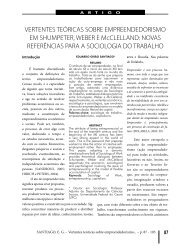Edição completa - Revista de Ciências Sociais
Edição completa - Revista de Ciências Sociais
Edição completa - Revista de Ciências Sociais
You also want an ePaper? Increase the reach of your titles
YUMPU automatically turns print PDFs into web optimized ePapers that Google loves.
A R T I G O<br />
O BARROCO COMO COSMOVISÃO MATRICIAL DO<br />
ÊTHOS CULTURAL BRASILEIRO<br />
_____________________________<br />
DR. EDUARDO DIATAHY B. DE MENEZES<br />
Comunicação apresentada na 25ª REUNIÃO BRASILEIRA DE ANTROPOLOGIA, em Goiânia (GO), <strong>de</strong> 11 a 14 <strong>de</strong> Junho <strong>de</strong><br />
2006, como Coor<strong>de</strong>nador da Mesa-Redonda - «Antropologia & Estética: A Arte como Gnósis e Visão do Mundo», que teve como<br />
Participantes: Dr. Or<strong>de</strong>p José Serra (UFBA), Dr. Rafael José <strong>de</strong> Menezes Bastes (UFSC) e Dra. Idilva Maria Pires Germano (UFC).<br />
_____________________________<br />
RESUMO<br />
Trata-se o presente Projeto <strong>de</strong> uma explanação <strong>de</strong> resultados preliminares <strong>de</strong> uma pesquisa exploratória em andamento<br />
e mesmo numa fase inicial, a <strong>de</strong>speito <strong>de</strong> anos <strong>de</strong> meditação sobre a temática. O esforço <strong>de</strong> caracterização do Barroco<br />
implica não só analisar a diversida<strong>de</strong> <strong>de</strong> conceitos que o termo alberga, mas também verificar o processo evolutivo por que<br />
tem passado tanto em sua <strong>de</strong>finição quanto em sua apreciação. Grosso modo, po<strong>de</strong>mos didaticamente imputar aos gran<strong>de</strong>s<br />
estudiosos do Barroco sua filiação a duas correntes <strong>de</strong> concepção antagônicas: 1) a sua percepção como fenômeno cultural<br />
historicamente <strong>de</strong>limitado entre finais do séc. XVI e meados do XVIII (mas cujos balizamentos temporais variam segundo<br />
o lugar social consi<strong>de</strong>rado, como ocorre com todo movimento cultural); e 2) a visão do Barroco como categoria transhistórica,<br />
encarnando-se <strong>de</strong> formas diversificadas em diferentes momentos da história e com uma geografia ampla e variada.<br />
As discussões se prolongam em seus <strong>de</strong>sdobramentos e inclinações; mas o mais brilhante <strong>de</strong>fensor <strong>de</strong>ssa compreensão do<br />
Barroco como espécie <strong>de</strong> éon, entida<strong>de</strong> abstrata, objeto <strong>de</strong> sucessivas encarnações e expressões, foi o filósofo espanhol<br />
Engenio D’ORS, que em sua obra Lo Barroco expõe sua teoria <strong>de</strong> modo sedutor. Mesmo com seguidores como Henri<br />
FOCILLON ou Ernst R. CURTIUS, o questionamento perdura em aberto. No que tange ao Brasil – objeto primordial <strong>de</strong>sta<br />
pesquisa – o território <strong>de</strong> exploração é imenso e tão-só o exemplo do campo literário, além <strong>de</strong> figuras do nível <strong>de</strong> um Gregório<br />
<strong>de</strong> Mattos ou um A. Vieira, o enriquecimento das linguagens e dos processos técnico-expressivos abriram perspectivas para<br />
novos estilos; o que faz com que a crítica atual acolha a existência <strong>de</strong> uma constante barroca ao longo <strong>de</strong> nosso processo<br />
histórico-cultural, como vem ilustrado em tempos recentes na poesia <strong>de</strong> um Jorge <strong>de</strong> Lima ou na prosa <strong>de</strong> um Guimarães<br />
Rosa, etc.<br />
ABSTRACT<br />
The present project is an explanation of the preliminary results of an on-going research, actually in its initial stage, <strong>de</strong>spite<br />
years of meditation on the theme. The effort to characterize the Baroque style implies not only an analysis of the diversity of<br />
concepts that the term embodies, but also a verification of the evolution process that it has un<strong>de</strong>rgone in its <strong>de</strong>finition as well<br />
as in its appreciation. Grosso modo, we may didactically impute to great scholars of baroque its filiation to two antagonist<br />
currents of conception: 1) its perception as a cultural phenomenon historically <strong>de</strong>limited between the final years of the XVI<br />
century and middle of the XVIII century(but whose temporal <strong>de</strong>marcations vary according to the social place consi<strong>de</strong>red as it<br />
occurs in all cultural movements); and 2) the vision of Baroque as a trans-historic category, being faced through diversified<br />
forms in different moments of history and with a broad and varied geography. The discussions are prolonged in their unfoldings<br />
and inclinations; but the most brilliant <strong>de</strong>fen<strong>de</strong>r of that comprehension of Baroque as a species of éon, abstract entity, object<br />
of successive incarnation and expressions, was the Spanish philosopher Engenio D’ORS, who, in his work Lo Barroco, presents<br />
his theory in a seductive way. Even with followers like Henri FOCILLON or Ernst R CURTIUS, the questioning still endures. As<br />
for Brazil, – the main focus of this research – the exploratory territory is immense, to mention as an only example the literary<br />
field, in addition to names at the level of a Gregório <strong>de</strong> Mattos and A. Vieira, the enrichment of languages and of technical<br />
and expressive processes opened perspectives for new styles; this makes the new criticism to accept the existence of a baroque<br />
constant along our historical-cultural process, as has been illustrated in recent times in the poetry of Jorge <strong>de</strong> Lima or in the<br />
prose of Guimarães Rosa, etc.<br />
BEZERRA DE MENEZES, E. D. O Barroco como cosmovisão matricial... p. 49 - 77<br />
<strong>Revista</strong> CIENCIAS SOCIAIS 39-1 ufc 2008.indd 49 16/10/2008 12:45:56<br />
49


